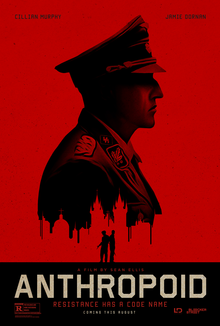| Anthropoid | |
|---|---|
 |
by Peter J. O’Connell
Anthropoid.
Released: Aug. 2016. Runtime: 120 mins. MPAA Rating: R for violence and some
disturbing images.
“Anthropoid” is a term referring to an ape—more generally, a
beast resembling a human. Operation Anthropoid was one of the most dramatic
incidents of World War II—the assassination in 1942 of Reinhard Heydrich, the
vicious Nazi ruler of the occupied Czech lands. Heydrich, a Hitler favorite and
architect of the “Final Solution” (Holocaust), was known as the “Butcher of
Prague,” the “Blond Beast” and the “Hangman.”
Now Anthropoid,
directed and co-written by Sean Ellis, tells the fact-based story of the plot to
kill the Beast. The film begins in late 1941 when a small group of fighters
sent by the Czech government-in-exile in London is parachuted into the
Nazi-ruled country. Two of them are Jan Kibis (Jamie Dornan) and Josef Gibcik
(Cillian Murphy). They become the main characters in the film. The difficulty
of telling patriots from collaborators soon becomes evident when two supposed
local resistance fighters offer aid to Kibis and Gibcik. The “resistance
fighters,” however, actually turn out to be traitors.
After killing one of the traitors, Kibis and Gibcik proceed
to Prague, where they spend several months in a safe house planning the
assassination of Heydrich, hampered by limited intel and little equipment. The
two men do, however, develop warm relationships with the family in the house
but engage in some heated exchanges with local resistance leaders, who doubt
that Operation Anthropoid can be pulled off and dread the inevitable Nazi
reprisals even if it can.
Finally, amid ratcheting suspense, the time comes for the
assassination attempt. The attack seems well planned, but then . . . . Well,
you know the old saying about the “best-laid plans.” However, Heydrich (Detlef
Bothe, with an amazing resemblance to the man he plays) does die as a result of
the attack.
And then the feared reprisals begin. And they are
horrendous. Thousands, including characters whom we have come to be fond of,
are imprisoned, tortured, killed. In one particularly excruciating torture, a
young violinist has his hands hammered while being “waterboarded” with whiskey
and shown the severed head of his mother in a fish tank. The reprisals are made
even more wrenching when it becomes known that a trusted person has become an
informer.
Eventually, the small band of lightly armed patriots responsible
for the assassination has to make a stand in a church against hundreds of SS
troops, who use heavy machine guns, explosives, gas and even fire hoses. The
sequence is brilliantly staged and quite moving.
Ellis’ direction is economical but deft and makes good use
of location shooting in the Czech Republic, including at some sites where the
actual historical events took place. His British leads and Czech, Slovak and
German supporting cast all do a fine job. The film is a powerful reminder of
the truth that “freedom is not free.”
“Footnotes” to the
film: (1) Noted Austrian/German director Fritz Lang stated that Nazi
propaganda minister Josef Goebbels offered to make him the head of Germany’s
film production. The anti-Nazi Lang declined and fled to France and then the
U.S., where over a 25-year period he made a number of classic films. One, Hangmen Also Die (1943), was inspired by
the Heydrich assassination but was not fact-based (because all the facts were
not yet known in 1943). (2) The intriguingly titled HHhH is another film on the Heydrich assassination and is
scheduled to come out later this year.
No comments:
Post a Comment